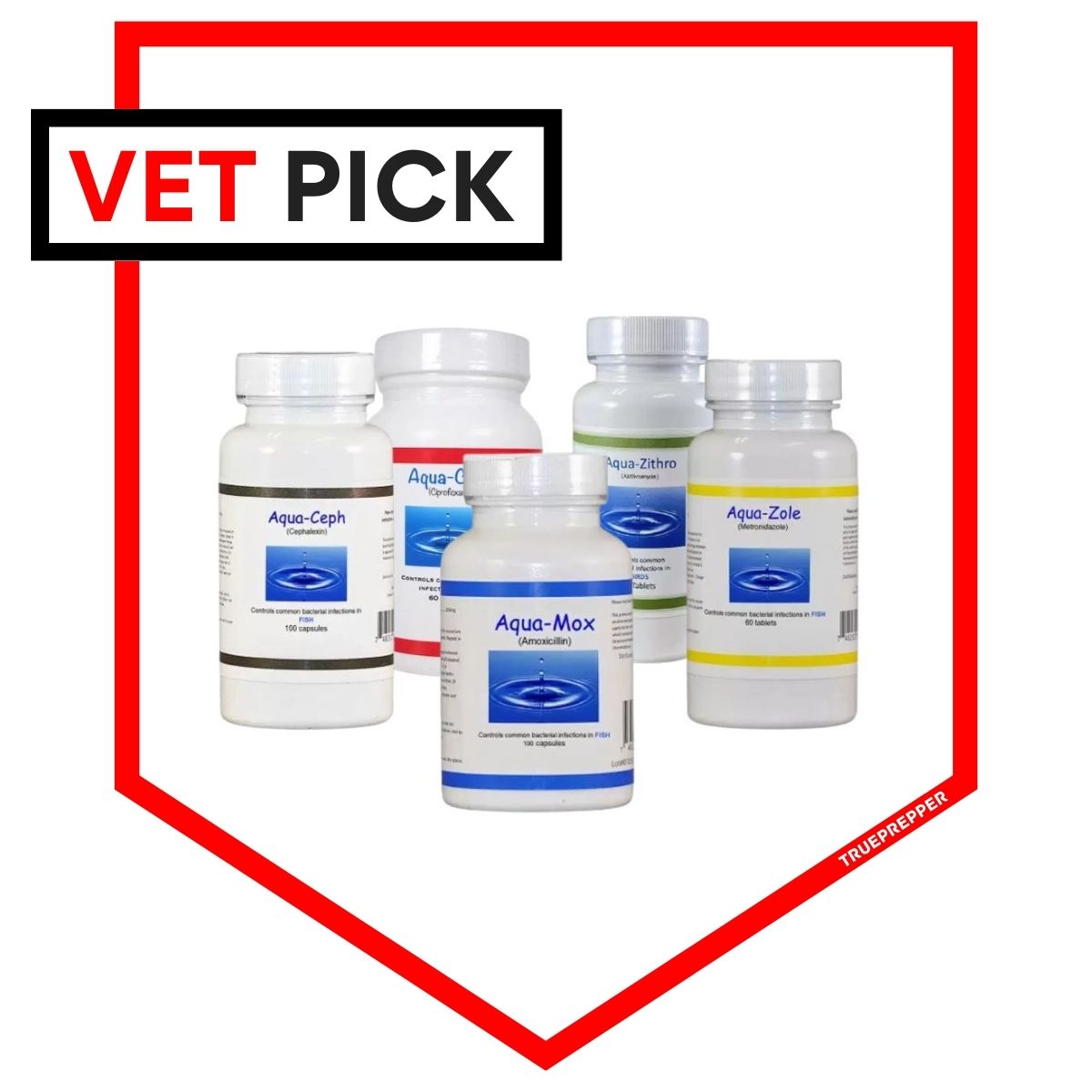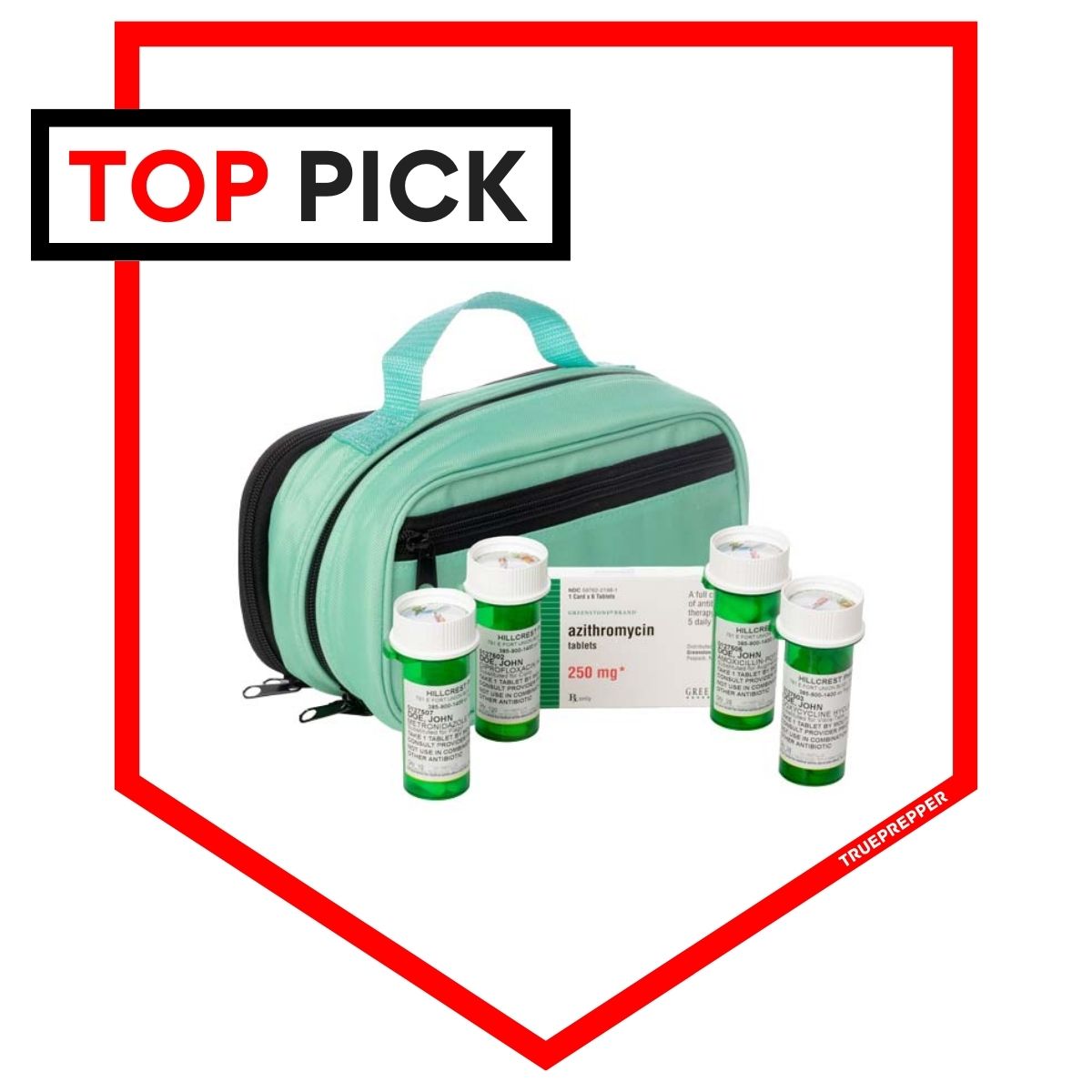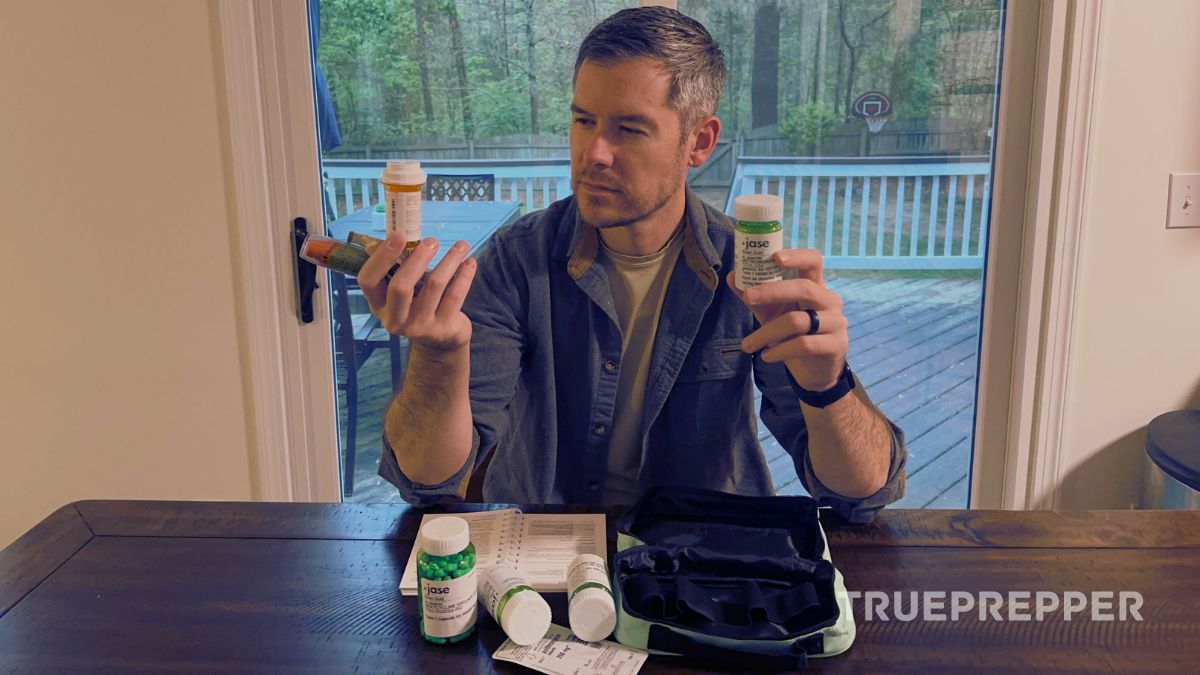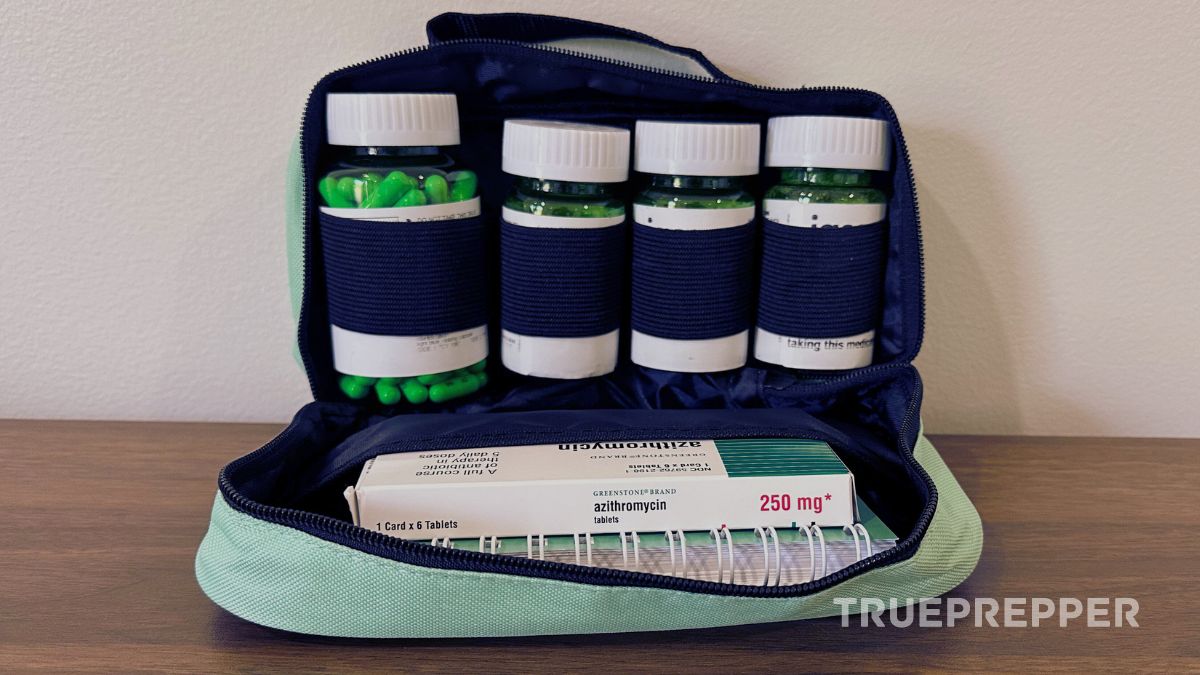Finally, you can get antibiotics for emergency storage. Everyone needs a medicine plan for emergencies, and one of the main battles when storing antibiotics is simply getting them. Getting FDA-approved antibiotics requires you to have a prescription, which is thankfully much easier now with emergency antibiotics kit companies.
With a quick survey and review with a doctor, the issue of finding prepper antibiotics is in the past. There are a few options to consider when it comes to antibiotics for prepping long-term medical storage: value, antibiotic type, ease of obtaining, etc.
This is where we come in. We’ve researched the best antibiotic suppliers, put in the physicians’ orders, and now the results are in: the overall best, a budget option, and an option for pets. If you need antibiotics that will help you stock your medical kit, one of our picks will help fill it.
Contents (Jump to a Section)
The Best Antibiotics
Jase Case
Easy, Expandable, and Versatile
Disrupting the medical industry by making antibiotics (and other medications) available without all the red tape.
*Price at time of publishing; check for price changes or sales.
Jase Medical has changed the game. Gone are the days of squirreling away antibiotics like contraband, they’ve actually managed to make getting antibiotics easy and relatively cheap! Their teal case is becoming quite iconic and includes these medications in the base Jase Case:
- 28 x Amoxicillin Clavulanate (875 mg), generic Augmentin
- 6 x Azithromycin (250 mg)
- 28 x Ciprofloxacin (500 mg)
- 120 x Doxycycline (100 mg)
- 30 x Metronidazole (500 mg)
You can also throw in these add-ons easily, making it an extremely versatile solution:
- 4x Fluconazole (150 mg)
- 21x Ondansetron (4 mg)
- 1x Epinephrine Pen (Epipen)
- Many types of OTC medication
When I went through the process, I was surprised at how fast but thorough it was. The questionnaire asks many questions about your medical history for the doctor to review but the survey only took me 5 minutes to complete (including the time for me to document the process!) You can find the full write-up on my personal experience with the Jase Case further below.
Pros
- The streamlined ordering process is easy to navigate and fast
- Good ‘base set’ of the best antibiotics included with important add-ons available
- Reasonable antibiotic stewardship was shown during ordering, and a thorough manual was included
Cons
- Somewhat expensive and doesn’t go on sale
- Jase limits order quantities and you cannot reorder within a year
If you are looking for emergency antibiotics, EpiPens, or other add-on medications, the Jase Medical Jase Case is simply the best scaleable option out there.


Budget Antibiotics
Amazon Pharmacy
Inexpensive, Insured, and Widely Available
Jump through some hoops by talking to your health provider and visiting an online or local pharmacy to get emergency antibiotics the traditional way.
*Your price varies by your insurance coverage.
Depending on your provider, you may be able to get emergency antibiotics from your doctor in advance of trips or other situations simply by talking with them and asking for a script.
Your doctor will know the best antibiotics to prescribe based on your medical history and any chronic conditions you have. The main drawback to this method is that many doctors are not willing to provide emergency antibiotics without a thorough review of why you need them.
This antibiotic stewardship is similar to the antibiotic kit companies, but most of those companies have streamlined the process to ask the right questions to provide the doctor with all of the information they need upfront. Navigating antibiotic stewardship yourself can be a significant hurdle.
Any pharmacy can fill once you have the prescription, but online pharmacies (like Amazon Pharmacy) can make it easy. If you have questions it may be easier to go to your standard local pharmacy to fill your order.
Pros
- Talking to your main provider could get you the best antibiotic setup for your situation
- Insurance coverage can make some antibiotics cheaper
Cons
- Doctors and pharmacists can refuse to write or fill prescriptions
- It requires a lot more coordination on your part
- No convenient kit or packaging
If you’re willing to put in the legwork and possibly shop family doctors around town, you could fill antibiotics prescriptions at an Online Pharmacy (or local) and create a kit tailored specifically for your family.

Vet Antibiotics
Walmart Vet Pharmacy
Non-FDA Approved, Not Cheap, and Meant for Fish
Hoarded for years by preppers, this is not a suggested nor a reliable option to get antibiotics in your preps.
*No longer available OTC as of 2024, see your Vet for details,
Aquarium antibiotics are under fire from the FDA, which has issued warnings to most sellers that they are not allowed to sell them without a prescription. This is to combat the growing bacterial resistance to antibiotics, which are medically needed by humans for serious infections. They match up to antibiotics you may recognize right on the front of their label, but they are not for human consumption.
Now you’ll need to head to your vet for any antibiotics, even for fish. Once you have a prescription for your animals you can fill it at the vet pharmacy (if available) or pick it up from an online vet pharmacy.
Obtaining antibiotics for pets and farm animals is much more difficult than before, and for good reason. Besides stewardship, vet antibiotics are not cheap. While the OTC change can be a headache for pet owners, you can still get your prescriptions filled online if you like.
Here is what is printed on the labels and their prices before they were restricted:
- Fish Mox Forte / Aqua-Mox Forte = Amoxicillin 500 mg, 100 ct – $59
- Fish Flex Forte / Aqua-Ceph = Cephalexin 500mg, 100 ct – $40
- Fin Flox = Ciprofloxacin 500mg, 30 ct – $65
- Fish Flucon = Fluconazole 100mg, 10 ct – $50
- Aqua-Doxy = Doxycycline 100mg, 100 ct – $96
- Fish Zole / Aqua-Zole = Metronidazole 500mg, 60 ct – $45
- Aqua-Zithro = Azithromycin 250mg, 30 ct – $100
Pros
- Restricted to veterinarian use as intended, improving antibiotic stewardship
- Dosed and prescribed correctly for your specific pet
Cons
- Limited by veterinarian availability and visit costs
- High cost relative to FDA-approved prescription antibiotics
- Not FDA-approved and NOT for human consumption
Nobody is supposed to be selling this stuff, so you’ll only find it on sketchy websites or by individual sellers. The FDA has sent letters to all of the reputable vet clinics asking them to stop distributing these without a prescription. We talk about that below where we look at whether fish antibiotics are safe for humans.

Luckily, preppers these days don’t hoard these. Getting emergency antibiotics for human use is possible, and all of these vet-specific medicines can now be left to the pets. Fish can be an important part of hydroponic setups, but that’s the extent of what we’ll recommend them for.
Everything We Recommend

Jase Case
Disrupting the medical industry by making antibiotics (and other medications) available without all the red tape.
Where to Buy
$269* at Jase Medical
*at time of reviewing

Amazon Pharmacy
Jump through some hoops by talking to your health provider and visiting an online or local pharmacy to get emergency antibiotics the traditional way.
Where to Buy
Varies* at Amazon
*at time of reviewing
The Kits We Compared
Our research narrowed the field down to the several antibiotics suppliers that we compared: Jase, Duration Health, Contingency Medical, traditional prescriptions, Aqua-Mox, Fish Mox, and more.
You can see our full list of review criteria below in the What to Look For section, with an explanation for each.
We focused on antibiotic tablets and capsules. We excluded topical antibiotics and antiseptics. Those are definitely useful for first aid kits and prepping, but address different issues than oral antibiotics.
To compare the services, I looked at the prescriptions offered in standard cases and available add-ons. I also compared pricing and went through the order process for each company to determine which processes were easier and more streamlined. Due to antibiotic stewardship, I was able to order one kit through the order process that was superior and documented the shipping time and service level.
We’re always looking for new and better medical strategies, so if you have an antibiotic brand or supplier that you swear by let us know in the comments. We review most of our roundups annually, so we can always try to pick some up for the next roundup round and see if they make the cut and we can see if they will beat out our top picks.
What to Look For
The best prepper antibiotics for long-term medical storage have several important features to look for. We weighed these in specific proportions to end up with our overall scores for each:
- Value
- Antibiotic Types (40% weight of overall score)
- Ease of Obtaining (40% weight)
- Packaging (10% weight)
- Versatility (10% weight)
When you get the right blend of these, you can find reliable antibiotics that will help you treat a variety of infections and ailments. Below, we break down what each of these features means for the antibiotic brands and suppliers that set themselves apart.

Value: Cost vs. Benefit
The amount of money you spend on something like antibiotics shouldn’t blow out your entire budget. This might be tough if you do not have insurance and are getting a prescription filled.
On the flip side, you don’t want to go too cheap or just plain get the wrong thing. There is no reason to resort to fish antibiotics, homeopathic solutions, or anything else now that antibiotics are readily available to store for emergency use.
You never want to spend too much money on one resource, especially something like antibiotics. While antibiotics are a hot commodity during disasters and emergencies, it’s better to diversify your preparedness equipment to make sure you are covered for a wide range of scenarios. There is a sweet spot where you get high value with not too high of a price, which is where our top pick sits.
Antibiotic Types
Many, many types of antibiotics are useful for targeting specific bacterial infections. Most of these fall into families, with the main families being:
- Penicillins – include phenoxymethylpenicillin, flucloxacillin, and amoxicillin
- Cephalosporins – include cefaclor, cefadroxil, cefalexin
- Tetracyclines – include tetracycline, doxycycline, and lymecycline
- Aminoglycosides – include gentamicin and tobramycin
- Macrolides – include erythromycin, azithromycin, and clarithromycin
- Sulfonamides – include co-trimoxazole
- Quinolones – include ciprofloxacin, levofloxacin, and norfloxacin
Some bacteria that cause infections (like MRSA) have become resistant to a wide range of antibiotics, while others have resistance to specific antibiotics.
Inappropriate use of antibiotics can contribute to these resistances, which is why antibiotics are prescription-only in most of the world.
The Best Antibiotics to Store (Types)
The best antibiotics to stock address a wide range of medical issues.
Here are the top antibiotics based on prescription frequency (according to the CDC):
- Amoxicillin – 24%
- Augmentin – 14%
- Azithromycin – 12%
- Cephalexin – 10%
- Sulfamethoxazole – 6%
- Metronidazole – 5%
- Ciprofloxacin – 4%
This shows that a basic antibiotics storage kit covers 59% of common prescriptions, and has functional overlap with many others in the list.
Basic Antibiotic Kit Coverage
Because there is a wide range of antibiotics a kit can include, kits have different medical coverage. To compare the various services, we looked at how the included antibiotics overlapped with the top types in the CDC list above:
Ease of Obtaining
Our top pick wasn’t even an option a few years ago. To get antibiotics for emergency storage, you’d have to get a little creative. Thankfully that’s no longer the case and antibiotics are easier than ever to store.
Doctors are increasingly concerned by bacterial resistance to antibiotics, so it is understandable why antibiotics are controlled behind the counter across most of the world. As long as you understand that you should only use antibiotics under a doctor’s direction, you won’t be contributing to the problem.
Many of these emergency antibiotic companies have you fill out a survey that is forwarded to a doctor for review. In my order with Jase, this survey took 5 minutes to fill out but was extremely thorough about my intended use, medical history, and medical support structure. Their attention to detail highlighted their committed balance between emergency availability and antibiotic stewardship.
No less than 19 hours later, a doctor licensed in my state reached out to me to confirm everything was in order and to reiterate the importance of emergency use and antibiotic stewardship. My prescriptions were filled one state away, so it shipped quickly too and I had the bag in hand three days later.
After sifting through the various kit ordering processes, here are the rankings:
Packaging
If you are taking your prepper antibiotics kit to go in a portable first aid kit, you don’t need an entire pharmacy. Survival kits are optimized to have the lowest weight because you never know when an emergency will require you to hoof it long distances.
Antibiotics, even in stockpile amounts, are lightweight and don’t take up much space. Almost every emergency medical supply company that we reviewed provided a small case to contain the prescription medicine. The cases themselves won’t be showing up on our best survival backpack review anytime soon, as they aren’t very durable- but they get the job done.

Versatility
The versatility of an antibiotics supplier is related to the different types of medicine they ship (both prescription and over-the-counter) beyond their basic kit. The basic kits are what we compared up until this point, but convenient add-ons can be helpful when you are rounding out your emergency medicine storage.
Jase, for example, lets you tack on a wide variety of prescription medicines and offers different types of kits based on what you need. Some kits, like the Lifesaver line from Duration Health, include all of these add-ons and can cost several thousand dollars.
Antibiotics Shelf Life
Antibiotics in portable kits may degrade fast, so you’ll need to watch the tags for shelf life. Store them in a cool and dry spot and they’ll last year though. I prefer to keep them out of reach of kids (of course) and in a cool spot so I won’t have to cycle them out until at least 5 years from now.
Since all antibiotics are from pharmacies, they all pretty much have the same shelf life at this point. The variance occurs with the delivery method: powder, capsules, pills, oral suspension, eyedrops, and topical cream can all affect the shelf life and how well the antibiotics store.
While most dry antibiotics will expire 2-3 years after manufacture, some like Amoxicillin suspension will only last 7-10 days.
None of the kits we compared included suspension, except for a few with eyedrops (for pink eye) that last longer than a year on the shelf.
Are Fish Antibiotics Safe for Humans?
No, it is not safe to take fish antibiotics.
While you may have historically seen prepping sites compare various antibiotics with fish versions, there are a few major issues. Fish antibiotics are manufactured without regard for safety and health, unlike regular antibiotics, and are not FDA-approved, and sometimes are not even lab-grade.
The FDA recently went after many vet supply stores, including Chewy for selling OTC animal antibiotics, as reported by Reuters in late December 2023. This has resulted in over-the-counter fish antibiotics being almost impossible to find now. It’s just a matter of time before any leftover distributors receive a letter similar to Chewy’s from the FDA.
Just because there are equivalencies between fish antibiotics and what your doctor prescribes doesn’t mean you should self-administer. In a wild SHTF scenario, you might consider it- but why would you have fish antibiotics lying around but not an easily obtained antibiotic kit?
The days of fish antibiotics for prepper emergencies are behind us. Here is a great, rational breakdown of our top pick vs. fish antibiotics:
Who Needs a Kit?
Antibiotics are an essential part of a survival first aid kit, and those are essential in almost every in-place and mobile survival kit. Whether you use a supplier or piece together your own, an antibiotic kit makes sense for preparedness.
At the very least you should have them in your home as part of your in-place first aid kit:
Luckily, they are not as hard to come by anymore. On rare occasions, some people have allergic reactions to antibiotics so you should check with your doctor before adding prepper antibiotics to your kits on hand (if you haven’t already).
How We Review Products: We research thoroughly before selecting the best products to review. We have vast prepping and survival experience and bring in outside experts when needed. Hours on end are spent testing gear in stressful conditions and using specialized testing gear to verify claims. We assign performance criteria and impartially rate each tested item. Learn more about how we test.
Sources and References
All of our experience and the testing we do to determine the best prepper antibiotics supplier is useless without listing our research sources and references. We leaned on these for the book knowledge that we paired with our hands-on testing and practical military and prepping experience:
Aminov, R. (2009). The role of antibiotics and antibiotic resistance in nature. Environmental Microbiology. Volume 11. Issue 12. Pages 2970 – 2988. (Source)
Mazer-Amirshahi, M., et al. (2017). Newly approved antibiotics and antibiotics reserved for resistant infections: Implications for emergency medicine. The American Journal of Emergency Medicine. Volume 35. Issue 1. Pages 154 – 158. (Source)
Zang, W., et al. (2020). Online availability of fish antibiotics and documented intent for self-medication. PLoS ONE. Volume 15. Issue 9. (Source)
The Final Word
Having antibiotics on hand can literally be a lifesaver during an emergency or disaster. Supply chain disruption and power outages occur with most regional disasters and national catastrophes, and antibiotics will be tough to get. Don’t let an infection threaten your life.
Here are a few related articles our readers have also found helpful:
We presented quite a lot of information, but as always: if you have any questions let us know and we would be happy to help. Our research and testing found the Jase Case Antibiotics Pack to be the best option given its value, included antibiotics, ease of obtaining, packaging, and versatile options.
If you pick up one of our suggested prepper antibiotics kits- make sure you are familiar with them and know when to use them. Don’t contribute to bacterial antibiotic resistance and know the basics of which type of antibiotic is for specific infections.
Keep exploring, stay prepared, and be safe.
Prepare Your Way With Us
No judgement and no imperatives. Prepare the way you want to with the trusted source millions of modern preppers have relied on.
Our newsletter fires out every Monday where you can expect:
- Practical prepping guides and tips
- Thorough survival gear reviews
- Noticeably absent spam and popups
- < 0.4% of people unsubscribe
Read the full article here
